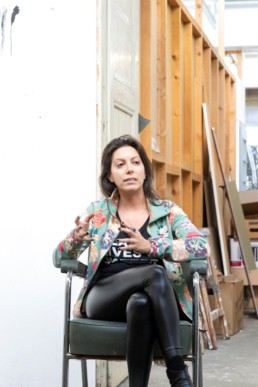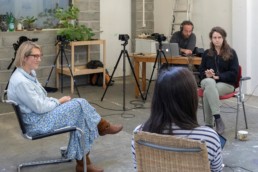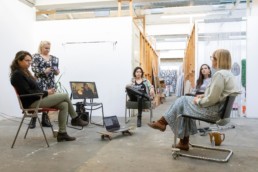CONVERSATION N.1
2020
Five artists and art historians exchange ideas about art, choices and everyday life.
With Emmanuelle Antille, Nina Haab, Elisa Rusca, Laura Thiong-Toye and Isaline Vuille
Saturday 10 October 2020
HD video, 62’09
Colour, sound. Language: French.
At the invitation of Nina Haab, five women artists and curators met in her studio at the Usine Kugler in Geneva. Given the health situation, their meeting was broadcast online; due to quarantine, one of the participants was present via Skype.
Conceived following a request from the Swiss Art Awards, the system put in place reflects a specific aspect of the artist’s practice: the exchanges that subsequently generate the production of images and objects. To initiate the conversation, Haab posed some broad but essential questions: how do you deal with art on a day-to-day basis? How do you combine your artistic or curatorial practice with your personal life and your so called side jobs?
This conversation gave rise to many testimonials, particularly on teaching. Perceived by those who work as art teachers as a very important activity, it gives them a foothold in society and allows them to exchange ideas with younger generations.
The place of women on the art scene was also discussed. The discussion started form the fact that although women represent the majority of art school students, especially in the first years, they are not as present, later on their career, in exhibitions, art centres or galleries. It should be pointed out that it is not uncommon for students, male, female or other, not to continue their artistic practice, either because they move on to something else or because, over time, they are unable to reconcile everything: private life, artistic practice and side jobs.
After all, it’s a question of balance, a subject much-discussed at the meeting; Obviously, these are issues specific to each person, but they particularly affect independent artists ad curators. It’s a question of balancing the time devoted to each part of life as well as the need to find a necessary financial balance. Like in a Tetris game, the different professional mandats, whether one is self-employed or salaried, interlock; projects and artistic research unfold to varying degrees; private life, friendships and family, also seek their place.
What emerged from the discussion was that the stereotype of the artist entirely devoted to his or her art, free from material contingencies, does not hold water. Financial difficulties are common in this field, and even recognition is unlikely to completely resolve material insecurity. By opening up discussions on these issues, Haab wanted to bring what usually is a private matter into the public arena, to affirm, through the exchange of experiences, a form of solidarity. This, with the purpose of imagining other ways of working.
Isaline Vuille (art historian and curator)
Image / sound: Jean-François Vercasson
Instagram Live Streaming: Valentyna Gueniat
Photographer: Guadalupe Ruiz





